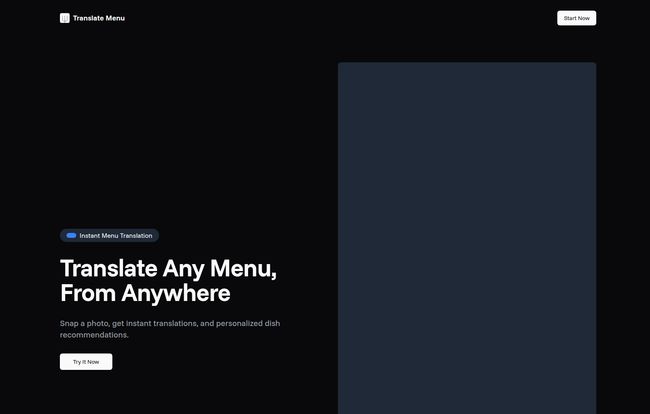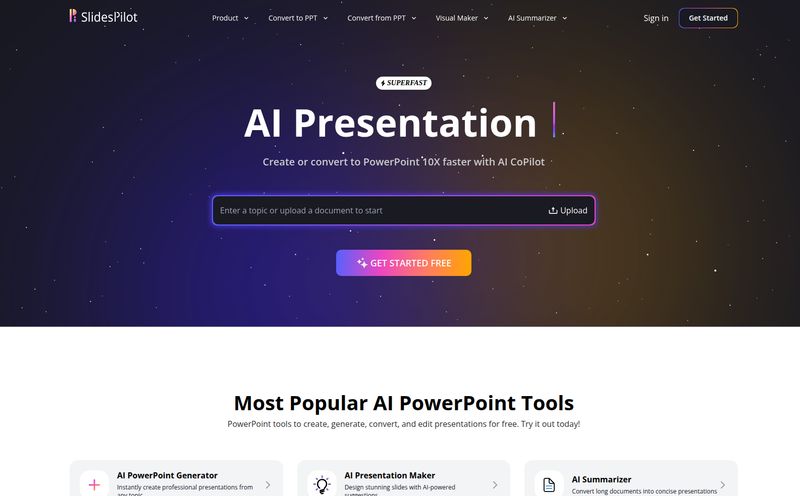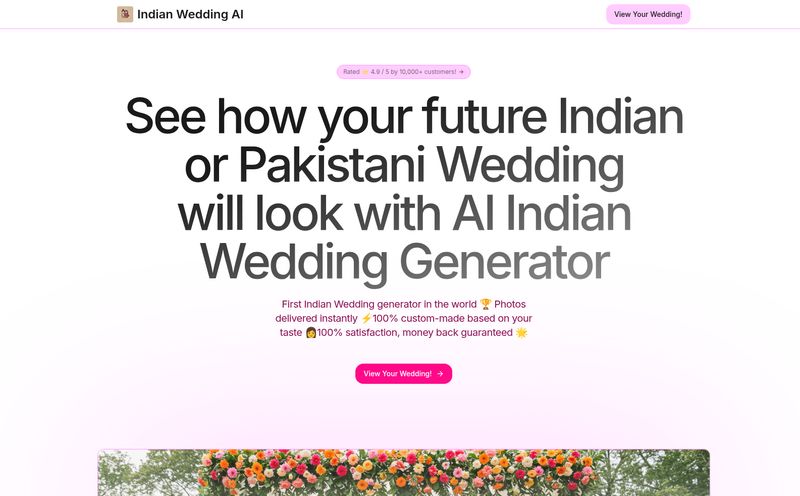We’ve all been there. You’re sitting in a charming little restaurant in a country where you don’t speak the language. The ambiance is perfect, the wine is local, but the menu might as well be written in ancient hieroglyphs. You stare at it, a mild panic setting in. You try to discreetly pull out Google Translate, pointing your camera at the cryptic text, only to get a literal, often nonsensical translation. Is "Grandmother's Happy Chicken" a term of endearment or an actual dish? You end up pointing at what the person next to you is having, hoping for the best.
It’s a travel rite of passage, I guess. But what if it didn’t have to be? As someone who’s spent years looking at trends in tech and traffic, I get excited when a tool comes along that solves a real, tangible problem. And I think I’ve just found one for the perpetually hungry and confused traveler: Translate Menu.
So What Is This Translate Menu Thing Anyway?
At its core, Translate Menu is exactly what it sounds like. It’s an app or platform designed to translate restaurant menus. But that’s where the similarities to your standard translation app end. This isn't just about swapping words from one language to another. It uses AI to not only give you the name of the dish in your language but also to show you a picture of what the dish likely looks like. Genius, right?
It aims to take the guesswork out of ordering abroad. You snap a photo of the menu, and it transforms the foreign text into a visual, understandable guide. It's for the adventurous foodie who wants to try the local specialty but is terrified of accidentally ordering tripe. Again. (Don't ask).
How It Actually Works
The process seems ridiculously simple, which is always a good sign. From what I can gather from their site, it’s a three-step dance: Snap, Translate, See.
You take a picture of the menu with your phone. The app then gets to work, instantly overlaying translations in your chosen language. But here's the kicker – and the part that got my attention – it couples that translation with AI-generated images of the food. It’s the difference between reading the word “Empanadas Argentinas” and seeing a mouth-watering picture of a flaky, golden-brown pastry. You instantly know what you’re getting.

Visit Translate Menu
This visual component is a game-changer. It bridges the gap that text-only translation leaves wide open. It’s one thing to know a dish has chicken and potatoes; its another thing entirely to see if it's fried, baked, or in a stew.
The Standout Features I Noticed
Beyond the core function, a few things really jumped out at me as a tech and travel enthusiast.
Instant Translations That Just… Work
Speed is everything when you have a hungry family and a patient-but-not-that-patient waiter. The promise of “instant” translation is a big one. The platform supports over 50 languages, which covers a massive chunk of the globe's most popular travel destinations. This isn’t a tool just for trips to France or Spain; it's designed to be a global companion.
AI Dish Images Are the Secret Sauce
I have to come back to this because it's the unique value proposition. In the world of SEO and digital content, we say “show, don’t tell.” Translate Menu applies this to food. The AI-generated image acts like a little window into the kitchen. It gives you context, sets expectations, and frankly, makes you hungrier. It turns a functional task (ordering food) into an experience of discovery.
Personalized Recommendations for the Indecisive
This is a clever layer on top of the translation. The tool can apparently give you personalized dish recommendations based on your preferences and even dietary restrictions. For someone with a gluten intolerance or a nut allergy, this could be more than a convenience; it could be a critical safety feature. Even for the picky eaters among us, being able to tell an app “I like spicy food but hate cilantro” and having it guide you through the menu is like having a local food expert in your pocket. A digital sommelier for your supper.
My Honest Take: The Good and The Not-So-Good
Alright, let's get real. No tool is perfect, especially one relying on cutting-edge AI. As a professional, I’m always looking at both sides of the coin.
What I Loved
First off, the confidence this tool could provide is immense. The fear of ordering the “wrong” thing is a genuine source of travel anxiety for many. This melts that away. I also love that it encourages culinary exploration. You’re more likely to try something new and exciting like Bacalhau à Brás in Portugal if you can see a picture of a delicious-looking egg and potato scramble instead of just the words “codfish to the Brás.” It's about breaking down barriers, one menu at a time.
Where It Could Improve
Let’s be honest, AI can be a little… weird sometimes. The accuracy of the translations and the images is a big question mark. The provided info acknowledges that the translations might vary and the AI images might not be a perfect representation. We've all seen AI-generated hands with six fingers; I can only imagine what an AI-generated casserole might look like on a bad day. Furthermore, the tool’s effectiveness is going to be heavily reliant on the quality of the photo you take. A dimly lit restaurant, a crumpled menu, or fancy handwritten script could all throw a wrench in the works. It’s a limitation, but a predictable one for this kind of tech.
So, How Much Does Translate Menu Cost?
This is the million-dollar question, isn't it? As of writing this, there’s no pricing information available on their site. This could mean a few things. The tool might be in a free beta phase to gather users and data. It could be planning a “freemium” model, where basic translation is free but features like personalized recommendations are behind a paywall. Or it might be entirely free and supported by ads. Personally, I’m hoping for a generous free tier, because this feels like a tool that should be accessible to everyone.
Is It Better Than Google Lens?
This is the obvious comparison. Google Lens has a fantastic text translation feature that many travelers already use. And for a quick-and-dirty translation, it's great. However, Translate Menu isn’t competing on just translation. It's competing on the dining experience. Google Lens will tell you what the words mean. Translate Menu aims to show you what the food is and help you decide if you'll like it. That specialization is its strength. It’s not just a utility; it's a dedicated food discovery tool.
Frequently Asked Questions
- How accurate are the translations in Translate Menu?
- Like most AI translation tools, accuracy can vary. It's likely very good for common dishes and languages but might struggle with regional dialects, slang, or highly specific culinary terms. Always use it as a guide, not gospel.
- Do I need an internet connection to use it?
- Almost certainly, yes. The AI processing for both the translation and image generation happens in the cloud, so you'll likely need a data or Wi-Fi connection to use its main features.
- Can it handle handwritten menus?
- This is often a challenge for OCR (Optical Character Recognition) technology. While some advanced systems can read handwriting, it’s probable that Translate Menu works best with clear, printed text. A fancy, cursive font on a chalkboard menu might be tough for it.
- What makes it different from other translation apps?
- Two things: the AI-generated images of dishes and the personalized recommendations. It's purpose-built for diners, not for general-purpose translation.
- Is Translate Menu free to use?
- Currently, there is no pricing information available. It may be free, operate on a freemium model, or still be in a beta testing phase. We'll have to wait and see!
My Final Word on This Pocket Food Guru
I’m genuinely optimistic about Translate Menu. It’s a smart, focused application of AI that solves a problem many of us have personally experienced. It's a fantastic example of how technology can enhance our real-world experiences, not just distract us from them.
Is it going to be flawless? Probably not at first. But the concept is incredibly strong. By adding that visual layer and a dash of personalization, it goes beyond simple utility and becomes a tool for joyful discovery. For any traveler who believes the best way to experience a new culture is through its food, this could be an absolute must-have. I’ll certainly be keeping an eye on it and will probably download it for my next trip. No more mystery meat for me.
References and Sources
- Translate Menu Official Website: [Link to be added when available]



